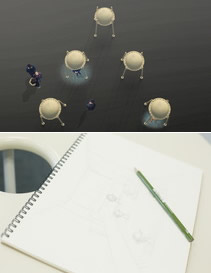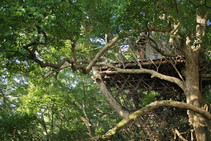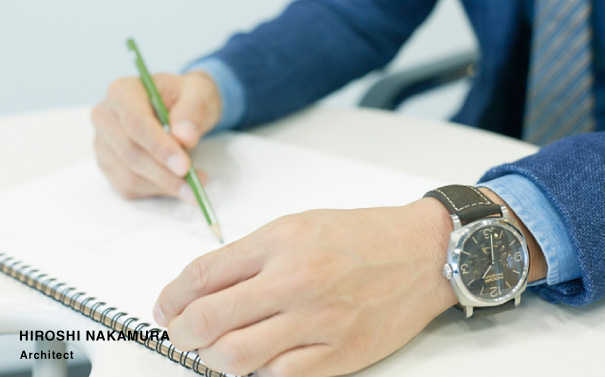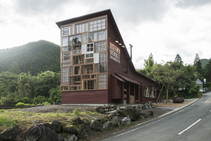
59 Hiroshi Nakamura(Architect)

Architect Hiroshi Nakamura has received many awards for his works. Among his well-known works are the commercial facility Tokyu Plaza Omotesando Harajuku and the wedding chapel Ribbon Chapel. For the "Tokyo Midtown DESIGN TOUCH 2015" event which began Oct. 16, Nakamura designed an installation for the "Salone in Roppongi" program, expressing the world of Italian luxury watchmaker Officine Panerai. We began the interview by asking him about the installation.
Architecture is about providing solutions
When designing architecture and spaces, the most important factor for me is the surrounding environment. Of course, I pay attention to the needs of the client, but if it's a commercial facility for example, I think about the products that will be placed there or the services that will be given. I believe designing architecture is about providing solutions, so my stance is not that of an artist making something to express himself.
The installation ("Salone in Roppongi presented by OFFICINE PANERAI"), was in a stairwell where it was impossible to shut out the light and sound, and the question was how to create the atmosphere of the sea there. Officine Panerai is a brand that started out by supplying the Italian navy with watches that could be used in the deep ocean. So I thought of conveying the history and appeal of the brand by replicating the sounds and sights of the diving experience.
In the venue, we placed five ball-like installations shaped like diving chambers. Light is projected inside each ball to evoke the scenes of the underworld and the diving sounds are replicated through a vibration speaker. When the diving chamber enters the waters, the world is at first a light marine blue, but the colors gradually change and ultimately become pitch-dark as you reach the deep undersea world.
It's as if the retinae of your eyes have been covered all over with blue paint and you are looking through them. Only the light changes, and sometimes you lose sense of perspective while at other times, the sense of perspective becomes sharpened. It's like the world in the movie "The Big Blue" - lonesome and at the same time somehow nostalgic. It's an installation that allows you to go deep sea diving in the middle of Tokyo.

Salone in Roppongi
"Salone in Roppongi" is a program that shows works by Japanese creators and companies who have exhibited at Salone del Mobile, the international furniture fair held in April every year in Milan. The photo above is a conceptual image of the installation, while the photo below is a drawing by Nakamura.
Officine Paneraii
A watchmaker founded in 1860 in Florence, Italy. The company makes luxury watches based on Italian design and Swiss watchmaking technology. Reflecting its history of supplying watches and precision instruments to the Royal Italian Navy, many of its watches have a nautical theme. The model which Nakamura is wearing is the popular "RADIOMIR 1940 3DAYS AUTOMATIC TITANIO-45mm" (see main photo on page 3.)
Brand history and a longing for limitless spaces
In the Panerai Officine watches, there are two layers - the watch face and a luminous-painted plate - and the numbers are cut out and made to shine. Diving deeper, the waters gradually darken, and I imagine that the watch must appear to shine more brightly the darker it gets. Of course, since it's a watch, it keeps telling the time with the same rhythm just as it does on land. The watch is a reminder of the outer world, and it must give a diver a strong sense of security and assurance which he would not experience in any other situation.
Architects usually design spaces that are limited - spaces that have walls and ceilings. That's why I have a longing for spaces without limits. I conceived the idea for this installation by thinking about the history of the Officine Panerai brand and my own longing for boundless space.
Striking a balance between conservation and capitalism
The relationship between trees and architecture has always been important in my work. The conventional way of making buildings has been to remove all the slopes and to flatten the ground. Big rocks and trees are taken out to make the land bare for the building. There have been numerous cases where factors such as the history and time of a place have been wiped out, and something new has been built from zero.
But when I make buildings, I try to make them stand in harmony with the trees. I start by observing the surrounding trees very carefully, and even conduct three-dimensional surveys, making simulations to find out facts like how the trees would shake during a typhoon. I aim to preserve the trees while getting the maximum possible space for the architecture. It's a challenge of striking a balance between the opposing aspects of environmental protection and capitalism.

Six trees for Roppongi in line with its name
You asked me for ideas to change the area of Roppongi from an architectural viewpoint; I think that in line with the name of Roppongi, you should plant six trees somewhere. There are various stories about the origin of the name, and one of them is that there used to be six trees.
Origin of "Roppongi"
Opinions differ about the origin of the name Roppongi which literally means six trees. Some say there used to be six pine trees, while others say Roppongi comes from the names of feudal lords who had residences in the area. The names were Aoki, Hitotsuyanagi, Uesugi, Katagiri, Kutsuki, Takagi and have the Japanese character of "tree" in them.
I wish we could plant really huge trees, but it would be a crime to transplant such large ones. Today, so many large trees are being cut down, as you can tell by looking at places such as the site of the former national stadium. Trees are being chopped away to make way for roads and condominiums and so on. It would be good if Roppongi could become a place for relocated trees. How about launching a project to save the large trees and planting six trees as symbols of the project?
The reason that temples usually have large trees is that people, ever since the old days, are naturally drawn to gather under trees. I was involved in the design of BIRD'S NEST ATAMI which is in a primary forest at the Risonare Atami resort; it's a tree house built in a way doesn't harm the tree at all. Using the latest technology to ensure harmlessness, we also made a small café that looks as if it's nestled in the branches, as well as a deck lower down the tree. We hoped to make it a place where people could come together and get in touch with nature. It would be nice if people could talk about their dreams for the future under that tree.

BIRD'S NEST ATAMI
A tree house built 22 meters above the ground in a camphor tree which is more than 300 years old. An iron truss structure built among the branches ensures that the treehouse does not harm the tree. It was designed by Nakamura and tree house creator Takashi Kobayashi.
No man-made design can be as wonderful as nature
Trees are important to me because I've been fascinated by treehouses ever since I was a child. That's why I became an architect. Trees also matter because in doing my job, I've come to realize that however hard an architect tries to make cool designs, nothing will surpass the wonderfulness of nature. Trees transpire water vapor and even when there is no wind, they move up the air and circulate it. Trees give off refreshing breezes and scents. When the light beams through the leaves of a tree, it is a beautiful sight. So my job is to think about how all those elements can be incorporated into the inner space of architecture. I've come to the conclusion that the coolest thing I can do is to give the leading role to nature and the supporting role to architecture.
In the towns too, I think it's become increasingly important to plan environments that help creative people to unleash their imagination. In addition to being convenient and having massive data, a city should have nature such as beaches and woods. The kind of places which will be most needed in the future are places which have urban functions but at the same time are also like resort areas.
There are many towns which have placed priority on capacity and efficiency, and are functional places for carrying out manual labor, but which are questionable as places for creativity. In that regard, I think the big attractiveness of Roppongi is that people can live and work in facilities like Roppongi Hills and Tokyo Midtown which are located near rich greenery. The two facilities have such a strong presence though, and I feel it would be better if smaller shops owned by individuals could become more fun and chic. And if all of them could become more connected to each other, I'm sure a town of the future can be created in Roppongi - one which will give birth to new things and not be tied down by established values.
Cities used to be made from local materials
There are limestone quarries in the underground of Paris; the city was built using this limestone. When you travel through Morocco, you see many different colored walls which reflect the various types of earth in each region. Cities used to be made from local materials which were in line with the environment and climate of their location. I've visited many cities and I appreciate the appeal of each. Since I take a neutral view, there's no city that I particularly like. In fact, I don't think it's good to have favorites.
But if pressed, I would say that I find Fez in Morocco intriguing. It's like an ant nest with narrow roads sprawling all over; it's a city of mazes where you just can't get out. Even with a map in hand, you keep coming back to the same place and the shops all look the same. It would be awful if you arrived there at night. (laughs) There are not many street lamps. Sometimes you sense someone near and look behind you, but they're all wearing veils so only their eyes are visible. All kinds of people come up to talk, but you feel you can't trust them. Even though I personally had some frightening moments there, I think Fez is fascinating.

A sense of mystery gives appeal to a town
I suppose the appeal of the city lies in its mystery. So much information is on the Internet now for everyone to see, and the number of unknown spots in cities is getting smaller. That's why I think the kind of towns that will become more alluring are those which you need to physically visit and explore to understand. Come to think of it, there's some mystery in Roppongi too; its nighttime face is very different from its daytime face, and it still has its unfathomable areas.
You can buy anything online now, so a big challenge for architects is creating motivation for people to visit a place. And so we try to create unique spaces - spaces where one-of-a-kind activities are held, or which have distinct localities, or where communication between people can expand. Perhaps one of the keys to architecture is creating a sense of mystery which can lead to intense experiences.
A future that is linked to the past
It's taken me some time to realize this, but it recently occurred to me that spaces which can be understood as soon as you enter them are dull, and people soon lose interest. But in reality, achieving the ideal is not easy. When an architect decides on a concept and makes something to purely reflect that concept, he is essentially going through the process of making something easy to understand, and that in itself is the opposite of creating space that is mysterious. We architects are not accustomed to making things that are conceptual and yet cannot be completely grasped.
So far, I have not made architecture using the element of mystery in order to enhance the appeal of a town, but I do pay a lot of attention to locality whenever I design. For a building in Omotesando for example, I took the characteristics of the Omotesando neighborhood into account. I also usually look at the stones or trees of a place. We talked about the six trees of Roppongi earlier. It's important to think about the origins and history of a place - the distinguishing features of a place. After you have explored all the factors that make a place distinct, then you need to make something special. And my wish is make things that will be relevant in the future.
Modern society has viewed the future as being something completely new and consisting of things that have not existed before. I think this view has led us to lose many valuable things. We don't want a future where human beings will be destroyed. We want a future where society is sustainable, and I believe that by looking at the way humans have lived since primeval times, we can find all kinds of hints that we have not been aware of before. I'm not proposing that we engage in nostalgia. I'm suggesting that by connecting with the past, we can step forward into the future.
Pursuing a new yet nostalgic future

RISE & WIN Brewing Co. BBQ & General Store
Opened in May 2015, the facility consists of a general store, a barbecue garden, a microbrewery and tasting stand. Designed on the concept of "local production for local consumption", furniture and construction materials collected from garbage collection points were used to make the building.
I recently designed a building in Kamikatsu in Tokushima Prefecture called RISE & WIN Brewing Co. BBQ & General Store. The town of Kamikatsu has declared a "zero waste" policy and is promoting the three R's of reduce, reuse, recycle. In order to reduce waste, steps need to be taken at the manufacturing and retail stage, and that's why at RISE & WIN, there is a brewery, and a shop that sells items by measure and recycled products.
Beer is sold in big bottles and we ask the customers to bring the empty bottles for refills. Of course I designed the building with the future in mind, but the service of selling by measure evokes the atmosphere of a nostalgic future, doesn't it? Thinking about how we can create such new lifestyles is what interests me most right now.
Editor's thoughts
Listening to Nakamura-san's ideas for Roppongi, I remembered that Kundo Koyama-san had also suggested planting six trees. Their ideas seem similar but are slightly different. Nakamura-san proposes planting real trees as a step to conserve the environment while the trees Koyama-san had in mind were of the manmade, artistic kind. You can read compare their ideas by reading Koyama-san's interview here
(edit_kentaro inoue)


















